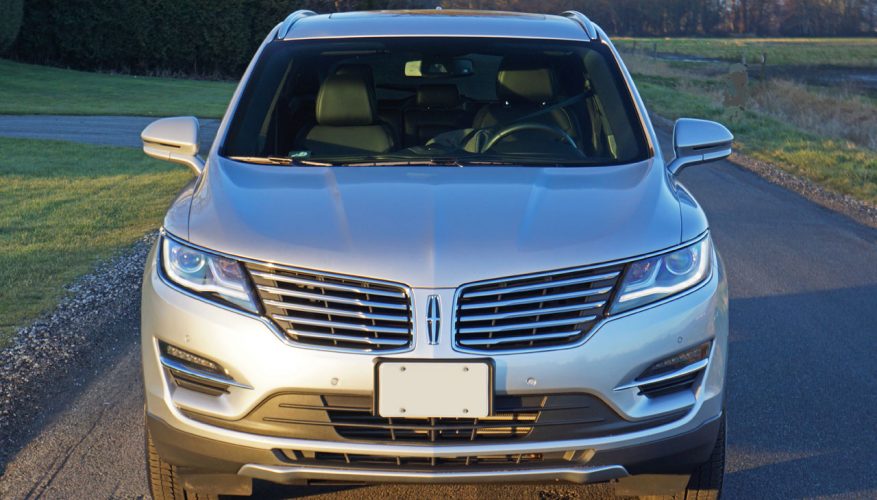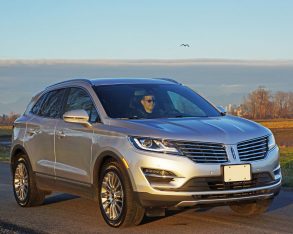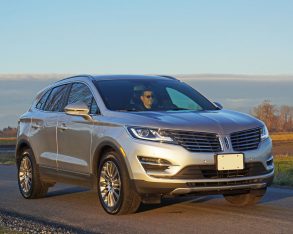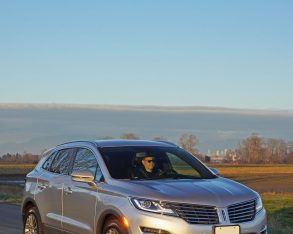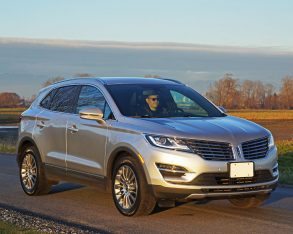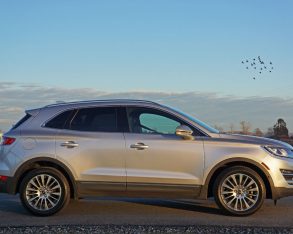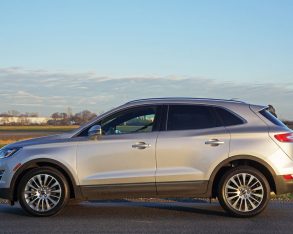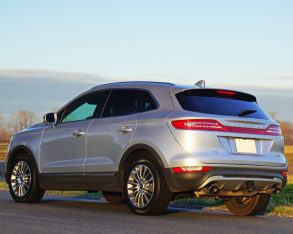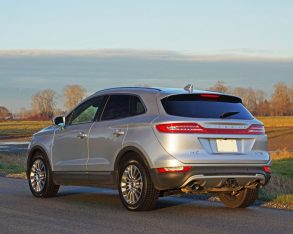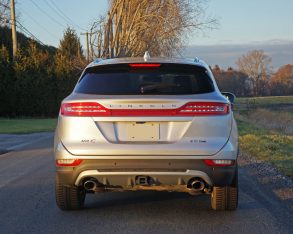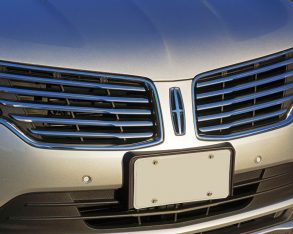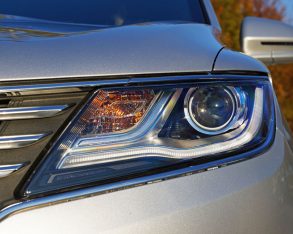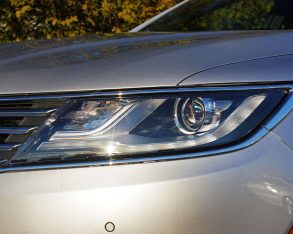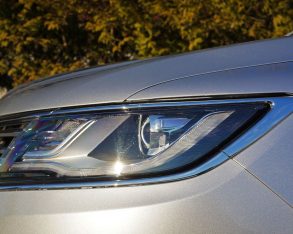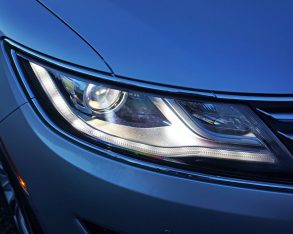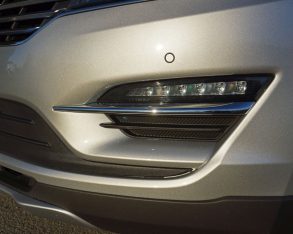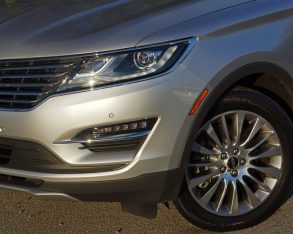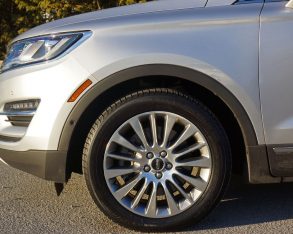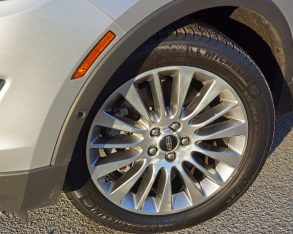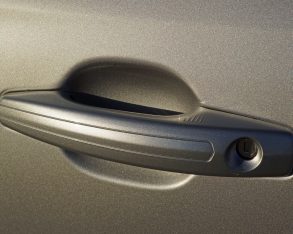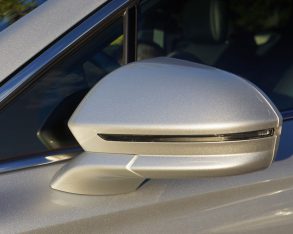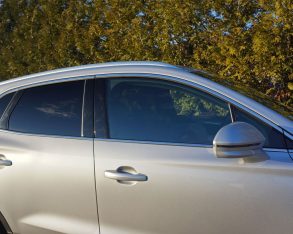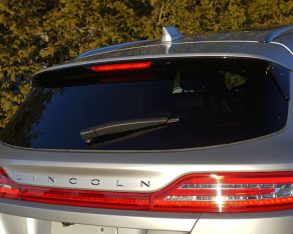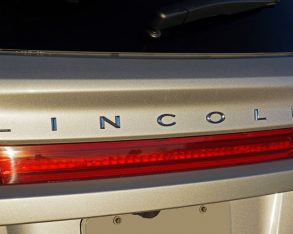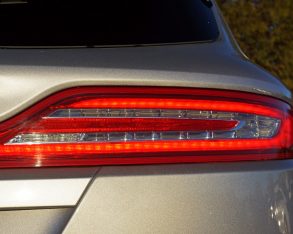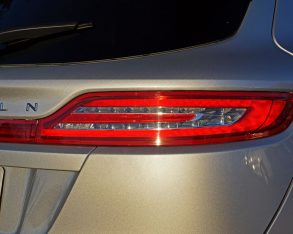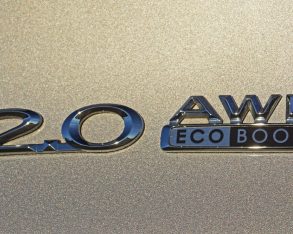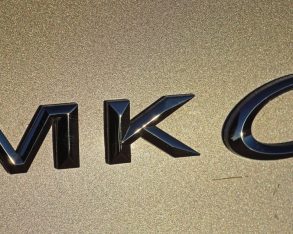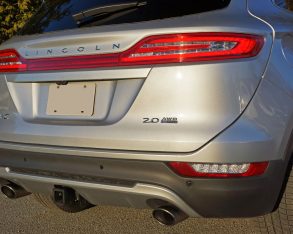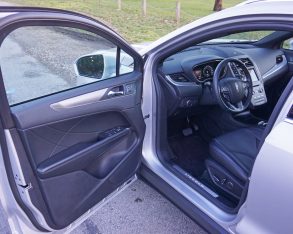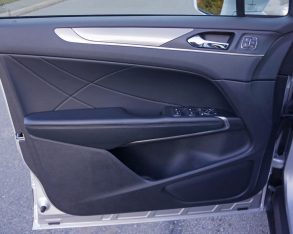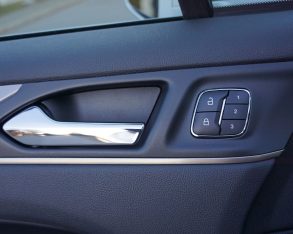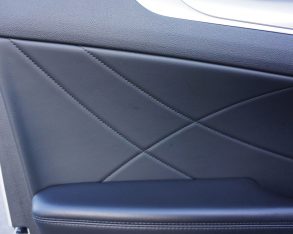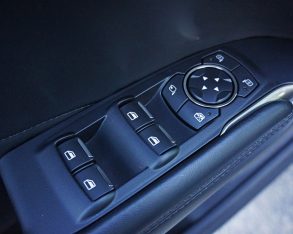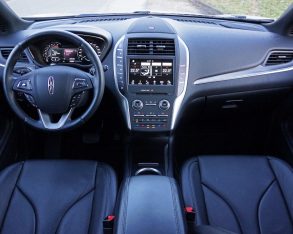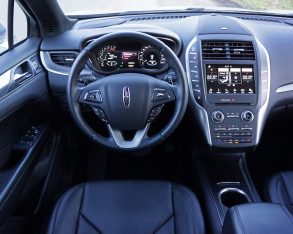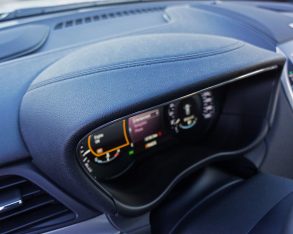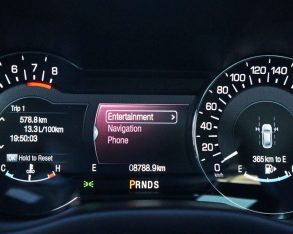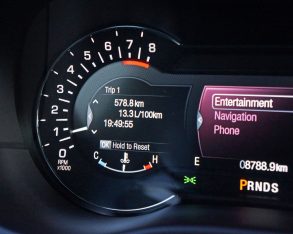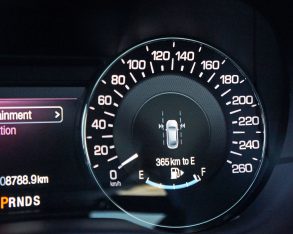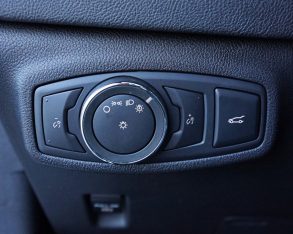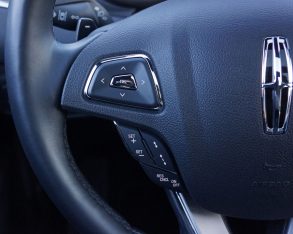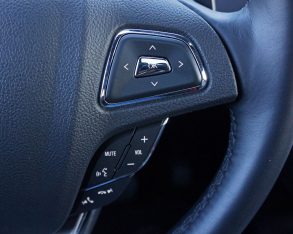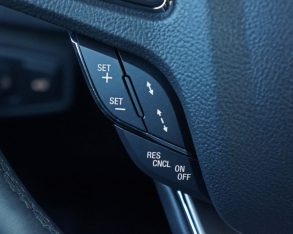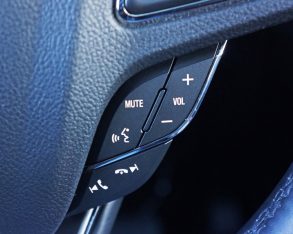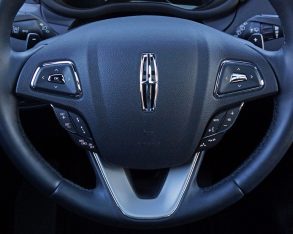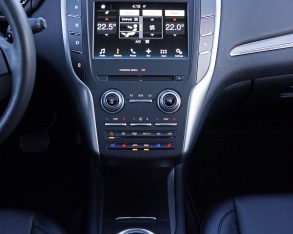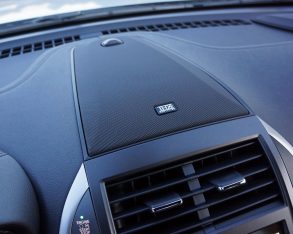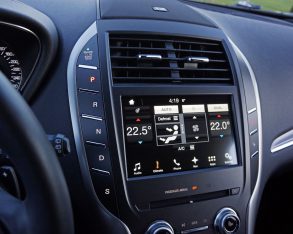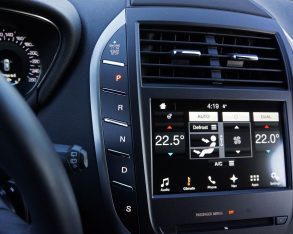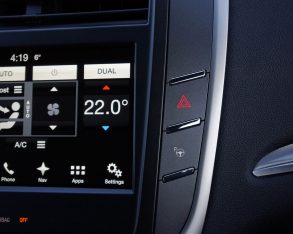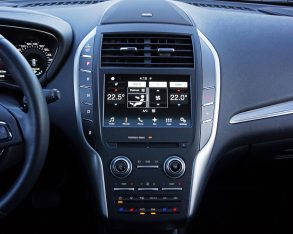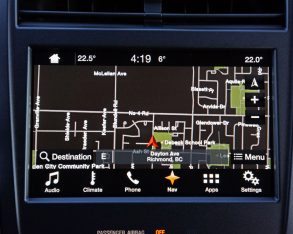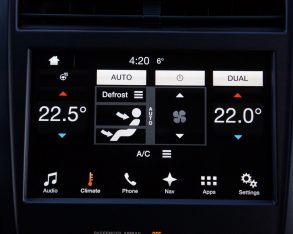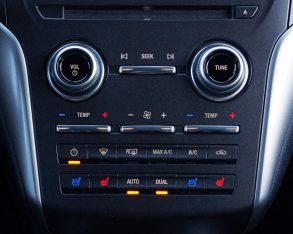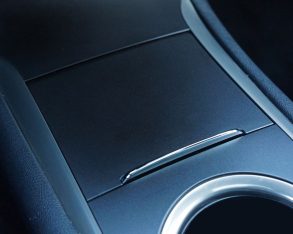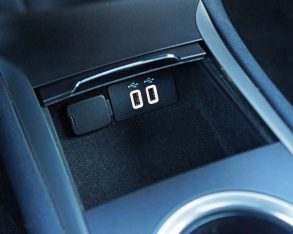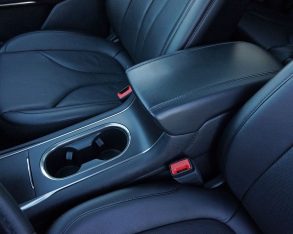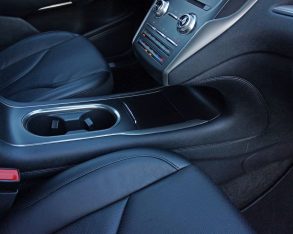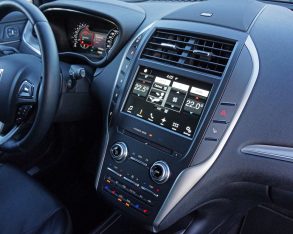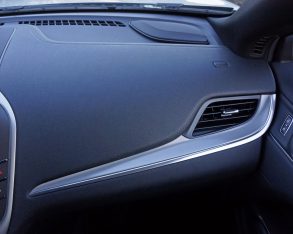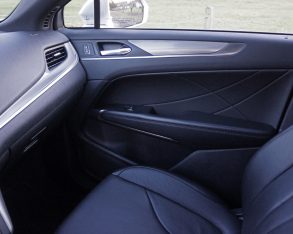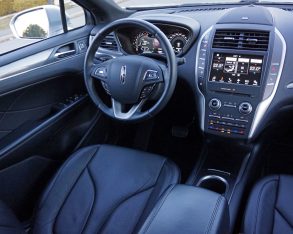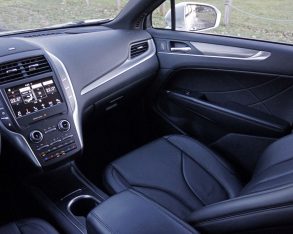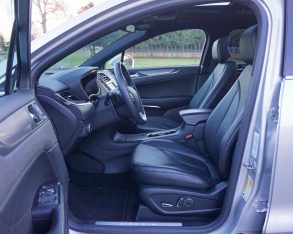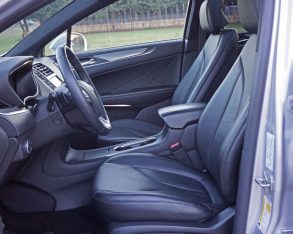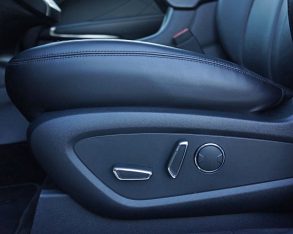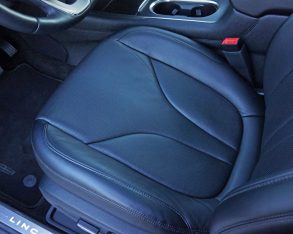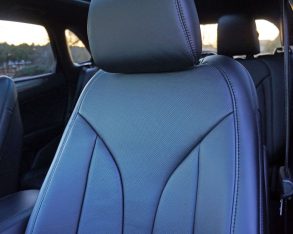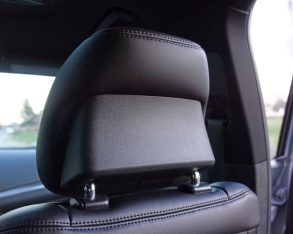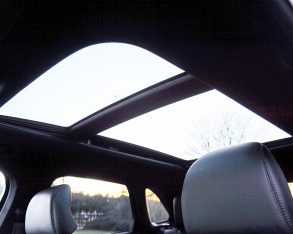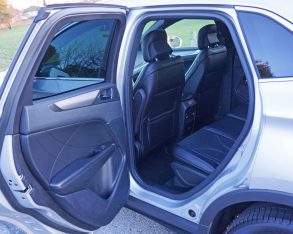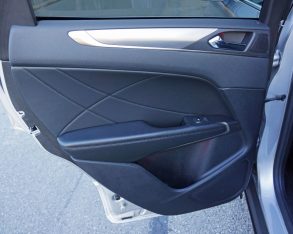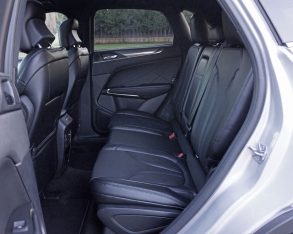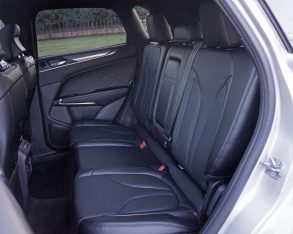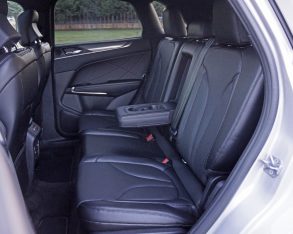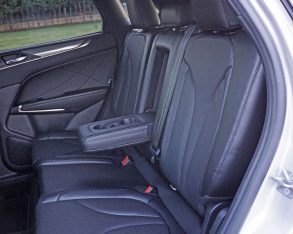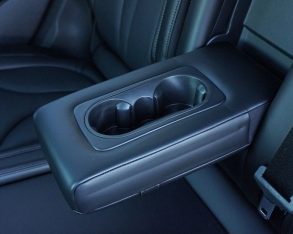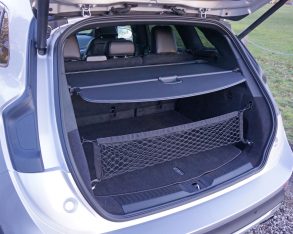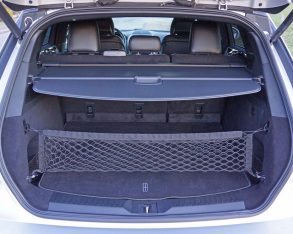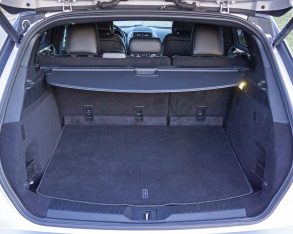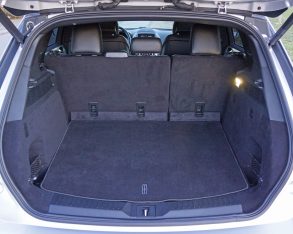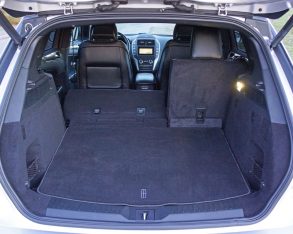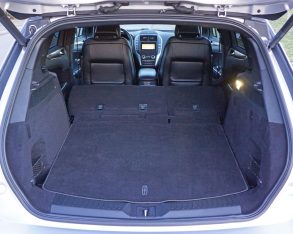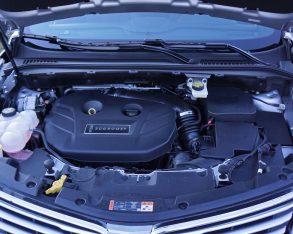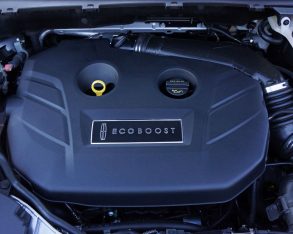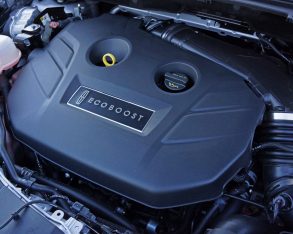There’s a lot to like about Lincoln right now. After years of experimenting with various styling directions they finally seem to be
 |
| Photo: Karen Tuggay, Canadian Auto Press |
on the cusp of culturing a distinctive personality that combines unique design elements in key areas, specifically the eye-catching split-wing grille up front and single slim taillight strip at back, both looking original and quite pleasing on every model they’ve been applied to, while the drive experience delivers competitive performance balanced with comfort-biased luxury.
The new look has given unique character to all of Lincoln’s models, from this MKC compact SUV, the smallest vehicle in its fleet, to the mammoth Navigator SUV, plus the MKZ mid-size sedan, MKX mid-size CUV, MKS full-size sedan and MKT full-size crossover. We actually saw the first signs of the split-wing grille fronting the 2009 MKS, a model I drove at its national launch and, in the ensuing review, stated that its “unique grille treatment” was “a completely new look for Lincoln that
 |
| Photo: Karen Tuggay, Canadian Auto Press |
will without doubt carry the brand well into the next decade, and maybe beyond.” Lincoln followed the MKS up with a split-wing for the refreshed 2010 MKZ and then-new 2010 MKT, plus the 2011 MKX, the newer current version of the design arriving for the 2013 MKS and 2013 MKZ, whereas a very different version was applied to the 2015 Navigator, while 2016 sees the brand’s most popular model, the MKX mid-size CUV, get the updated version of Lincoln’s new face. The subject of this review, the MKC, arrived for the previous model year and therefore still sports its own version of the stylish façade with zero external deviation for 2016.
There’s really only one way to see if it’s catching on: sales numbers. Here in Canada and the U.S., two of the brand’s primary markets (it also sells in modest numbers in the Middle East, China, Japan and South Korea), sales are on the rise. In
 |
| Photo: Karen Tuggay, Canadian Auto Press |
the U.S. the luxury brand sank to a 32-year low in 2013 with sales of just 81,694 units, but since the introduction of the MKC in May of 2014 it’s been the fastest growing luxury brand, with sales up 15.6 percent to 94,474 units that year. Sales continued to improve last year, increasing by 7.1 percent to 101,227, 2015 also marking the first time Lincoln has overcome the 100,000-unit hurdle since 2008. Even better, Lincoln’s Canadian sales grew by 16.4 percent to 7,939 units last year, although the division north of the 49th doesn’t have to look so far back on the calendar to find a year that bettered this result, with both 2011 and 2010 surpassing 8,000 units at 8,162 and 8,630 respectively, although 2009 back to 2007 saw the brand hovering in the high 5k to low 6k range, whereas 2006 back to 2004 it dipped into (in one case well into) the 4k range. Lincoln should be proud of its progress.
Still,
 |
| Photo: Karen Tuggay, Canadian Auto Press |
even with its recent success the Lincoln brand ranks ninth in popularity behind Mercedes-Benz, BMW, Lexus, Audi, Acura, Buick (although there are some that don’t consider Buick a true luxury brand), Cadillac and Infiniti. That it outsells Land Rover, Porsche, Volvo, Tesla and Jaguar is significant, but one of these only sells SUVs, another sells no SUVs (yet), one is a much higher-priced near ultra-premium brand, one is fresh as a baby’s behind and only sells electrics, and one would be considered brain-dead and on life support if it weren’t for Chinese ownership and an important new potentially lifesaving model. Of course, there have been a number of times in Lincoln’s 99 years that it could have been described similarly.
Wouldn’t it be nice for a lifesaving model to change everything for Lincoln on its forthcoming
 |
| Photo: Karen Tuggay, Canadian Auto Press |
centennial celebration? It won’t be the upcoming 2017 Continental, large luxury cars more about building brand image than increasing sales and overall profits, but it could be the combination of this MKC and the revised MKX gaining stride. The updated MKX will no doubt draw buyers into Lincoln showrooms, where many will find that the MKC is a better fit for their active lifestyles. That’s, at least, how we often see things in Canada. We love our compact SUVs, the Ford Escape that shares much of the MKC’s underpinnings by far our bestselling compact SUV with 47,726 down the road last year, the MKC doing fairly well for its pricier premium compact SUV class, the end result of its first full year of sales being sixth place out of 11 total premium models. This means that its 2,970 sales put it ahead of Infiniti’s QX50 (2,283), Porsche’s Macan (2,121), Volvo’s XC60 (1,646) and Land Rover’s new Discovery Sport (991), although
 |
| Photo: Karen Tuggay, Canadian Auto Press |
the Brit only arrived in May so you can effectively double those numbers. While not a bad showing, the MKC still has a way to go before it catches up to the BMW X3 (4,527), Mercedes-Benz GLK (5,304; soon to be replaced by the GLC), new Lexus NX (6,127), Acura RDX (7,380) and Audi Q5 (8,203). The numbers are larger overall in the U.S., of course, with the MKC having sold 24,590 units last year, but it’s eighth-place result means that it’s actually fairing better within its segment here in Canada.
Let me just say that the MKC deserves a much bigger piece of the pie in both markets. Not only is it very good at being a compact luxury SUV, but it’s much better at this job than a number of premium players that are much higher up on the sales charts, not to mention priced higher as well. The MKC is a relative bargain at just $39,190 plus freight and dealer fees. Only the QX50 sells cheaper at
 |
| Photo: Karen Tuggay, Canadian Auto Press |
$37,900, the rest priced over $40k starting with the Discovery Sport at $41,790, NX at $41,950, RDX at $41,990, XC60 at 42,000, Q5 at $42,600, X3 at $44,650, and new GLC at $44,950, plus the Porsche Macan at $59,200, but that one is really in another league altogether. If Lincoln’s offering was somehow inferior I’d say that this all makes sense, but in reality the MKC’s performance, level of luxury, list of standard features and overall refinement is quite a bit above average, only the Lincoln brand’s prestige coming into question.
Let’s put that unquantifiable factor aside for a moment and just look at the facts. We’ve already covered styling, which is a personal issue anyway, so let’s just sum it up by saying that it focuses on classy elegance instead of sporty performance. The same goes for the interior. Everybody knows the MKC shares much with the Escape
 |
| Photo: Karen Tuggay, Canadian Auto Press |
under the skin, but in similitude to how the RDX is built upon Honda CR-V underpinnings, the Lexus NX is a majorly reworked Toyota RAV4, and the Volvo XC60 pulls chassis architecture from the old Ford Fusion (yes, the previous Lincoln MKZ too), Lincoln has gone far to differentiate the MKC from its proletariat roots. For instance, most competitors don’t deliver as much soft touch interior surfacing. Really, only the lower dash panels, under the driver’s legs, and lower door panels get the hardened plastic treatment. The entire dash top is covered in a high quality soft synthetic stitched together with French seams, including a separately wrapped primary gauge hood, while the premium treatment flows all the way down the instrument panel as well. Ahead of the front passenger it even goes so far to continue all the way down to the lower panels, including the glove box lid. You won’t find this level of pampering in a Q5 or most of its contemporaries. Likewise each door upper gets the
 |
| Photo: Karen Tuggay, Canadian Auto Press |
same high-quality soft-touch synthetic, while the inserts just below are beautifully detailed with an artistic stitched pattern and even softer padding underneath, and the armrests are stuffed full of comfort too, again with attractive French stitching. But it gets better, Lincoln even padding the centre console sides, from the floor’s carpeting to the top edges, with the same attractive stitching down the middle, this extending all the way back to the centre armrest that again gets a French-stitched leatherette covering. I can’t remember a compact SUV that went this far to pamper its occupants, with none of the pricier Germans even coming close.
My favourite details, however, are the genuine aluminum inlays that cross the instrument panel and each door. They feature an eye-catching vertical textured pattern
 |
| Photo: Karen Tuggay, Canadian Auto Press |
and are surrounded by equally upscale satin-silver aluminum trim. There’s plenty of bright shiny chrome too, for the door handles and switchgear detailing. On that note, the MKC’s especially high-quality buttons, knobs and dials really set the benchmark in this class when it comes to fit and finish. There isn’t a trace of sloppy wiggle on the window switches, lock buttons or memory seat controls. Ditto for the steering wheel switchgear. All of the above are much higher in quality and more tightly fitted than supposed industry leaders such as Audi and Porsche, not to mention many others in this class. The same goes for the centre stack controls, which include Lincoln’s exclusive row of gear selector buttons, that I’m actually starting to like, plus audio and HVAC system interfaces that are mostly filled with touch-sensitive “buttons” on a metallic feeling surface. Of course, the standard HVAC system is automatic and dual-zone, while standard three-way heatable seats also had the ability to cool via a trio of settings in my upgraded test model.
On
 |
| Photo: Karen Tuggay, Canadian Auto Press |
top of all this the MKC comes standard with Lincoln’s new Sync 3 infotainment system that’s so far ahead of most of its rivals that it’s hardly a fair fight. I first tested this system in Ford trim, and it’s virtually the same under Lincoln badging other than some graphics and colours. Where the blue-oval brand fittingly uses blues on a white background, Lincoln boasts rich gold and black tones. The graphics are as modern as possible, especially likeable to those who appreciate minimal clutter, while the system functions more like a smartphone than any previous automotive application. It syncs perfectly with Android phones, or so I experienced, while everything I’ve heard from iPhone users is equally positive. You couldn’t find a clearer, brighter, higher resolution display, while its eight-inch diameter
 |
| Photo: Karen Tuggay, Canadian Auto Press |
is also impressive for the class, even when comparing most rivals’ top-line systems. Sync 3 is standard, as are the handy five-way steering wheel controls allowing safer operation.
While all of this would impress any would-be buyer that actually took the time to shop around rather than just purchase on brand name alone, Lincoln’s standard MKC features menu wows even more. In case you’re wondering, most of the MKC’s competitors don’t offer remote start or proximity-sensing access with a pushbutton ignition system in base trim, let alone FoMoCo’s exclusive SecuriCode keyless entry. The majority won’t give you standard leather upholstery in their entry-level trims either, nor do they include a 10-way powered driver’s seat with two-way powered lumbar and memory plus a powered passenger seat. Some don’t even wrap leather around the steering wheel, or include real aluminum trim until
 |
| Photo: Karen Tuggay, Canadian Auto Press |
moving up through their options lists. Lincoln does all that in its base Premiere trim level, plus ups the standard ante with active grille shutters to aid aerodynamics, auto up/down for all windows, an auto-dimming rearview mirror, a reverse camera, rear parking sonar, an AM/FM/CD/satellite audio system with nine speakers including a sub, two smart-charging USB ports, an overhead console with a handy sunglasses holder, LED map lights, an electromechanical parking brake, hill start assist, tire pressure monitoring, all the usual airbags plus a driver’s knee blocker, auto on/off HID headlamps with signature LEDs, LED taillights, 18-inch alloys, Lincoln Drive Control featuring Continuously Controlled Damping (CCD), all-wheel drive, a powerful direct injected and turbocharged 2.0-litre engine, and standard paddle shifters for its six-speed automatic.
Like
 |
| Photo: Karen Tuggay, Canadian Auto Press |
so many other features that come standard with the MKC, some of its competitors don’t offer paddles at all, these adding a level of driver engagement to the six-speed auto that’s truly necessary being that there’s no shift lever to fall back on. Lincoln is in good SUV company in this respect, Land Rover/Range Rover saying goodbye to traditional shift levers too. At first it’s a bit strange not having something to hold onto between the seats, but the paddles quickly make you forget any connection to what is essentially a passé bit of mechanical kit, at least with respect to modern-day automatics. On that note the Lincoln’s autobox is down a couple of gears from most rivals, the majority boasting new eight-speed automatics and others seven- plus now even nine-speed units. While more seems to be better, the MKC’s base engine puts out enough torque to make the need for more gears less noticeable. The advanced 2.0-litre turbo four produces a willing and able 240 horsepower and 270
 |
| Photo: Karen Tuggay, Canadian Auto Press |
lb-ft of torque, which incidentally is mostly the same engine used by the new Land Rover Discovery Sport and Range Rover Evoque, albeit these down 20 lb-ft of twist, and this is the MKC’s base power unit. Last year’s tester was equipped with the 2.3-litre Ecoboost, which comes stock with 285 horsepower and 305 lb-ft of torque. Obviously more power makes for greater fun behind the wheel, but I never once felt hard done by with the 2.0-litre’s output. The engine pulls strongly, the transmission’s shifts smooth and positive, and the standard all-wheel drive system provided excellent grip no matter the state of road surface. Braking was superb too, while the ride was probably the best I’ve experienced in any SUV for quite some time.
That latter point is a two-edged sword, mind you. While the MKC was sublime over
 |
| Photo: Karen Tuggay, Canadian Auto Press |
rough inner city roads, even more appreciated when driving through some of my area’s off-road-like laneways, and a joy anywhere else that pavement was in disrepair, its suspension setup was too soft for my liking, to the point that it bobbed to and fro on the highway and leaned too much through tight, fast-paced curves, at least when its Lincoln Drive Control selector was left to its own devices in default Normal mode. Fortunately it has a Sport mode that enhances the fun factor, but it’s still no track star. This doesn’t mean my tester didn’t hold its own through the corners where it’s actually quite capable, but it doesn’t stay fully horizontal throughout the process either, so it didn’t inspire the kind of confidence to push harder that more sporting SUVs do. Still, I don’t think this is what Lincoln was going after, and if you go back and review the sales numbers I noted above, I don’t think that’s primarily what buyers want. The top sellers are comfort-oriented
 |
| Photo: Karen Tuggay, Canadian Auto Press |
utilities with reasonable performance abilities, and while the MKC doesn’t track as well as say, the Q5 or RDX, it’s not far behind while its ride is far superior.
To achieve this it uses a sophisticated continuously controlled damping system capable of managing ride and handling via 12 sensors that monitor body, suspension, steering and braking activities non-stop, with up to 46 inputs every two milliseconds, the result being the impressive balance between ride and handing that I noted before, plus as little road noise, vibration and harshness entering the cabin as possible. This, combined with a low coefficient of drag, a layered acoustic glass windshield, active noise control, plus a lot of sound deadening materials and processes, makes for an extremely quiet cabin that suits Lincoln’s brand image perfectly.
That’s
 |
| Photo: Karen Tuggay, Canadian Auto Press |
all standard equipment, but my tester was filled with almost everything Lincoln could throw into it. Along with the standard list noted earlier, my MKC also came with most everything from the $42,050 mid-range Select trim line, such as power-folding side mirrors with integrated turn signals and memory, plus auto-dimming capability on the driver’s side, ambient lighting, an upgraded Wollsdorf leather-wrapped steering wheel, a 10-way powered front passenger seat with lumbar support, a universal garage door opener, a powered liftgate, and a cargo cover, while my $47,150 top-line Reserve trimmed tester added unique polished aluminum 18-inch alloys with dark stainless painted pockets, a powered tilt and telescoping steering column with memory, rain-sensing wipers, a windshield wiper de-icer, auto high beams, a heatable steering wheel, cooled front seats, heatable rear outboard seats, voice-activated navigation, an embedded modem that turns the SUV into a Wi-Fi hotspot, a large panoramic glass sunroof with
 |
| Photo: Karen Tuggay, Canadian Auto Press |
a powered shade overhead, 110-volt household-style inverter plug, a hands-free powered liftgate, and blind spot detection with cross-traffic alert.
My tester also included a $1,100 14-speaker 700-watt THX II audio system that sounded fabulous, plus a $2,250 Technology package that added active park assist which is capable of autonomously parking your MKC, plus adaptive cruise control, one of my favourite road trip features, a forward sensing system with collision warning and brake support that’s capable of autonomously slowing or panic stopping to avoid an accident when you might otherwise be distracted, and lane keeping assist to help you maintain your lane if attempting to merge into an adjacent one that’s already occupied. Finally, Lincoln added a Class II trailering package for $500. So equipped my tester stickered at $51,925 plus freight and dealer
 |
| Photo: Karen Tuggay, Canadian Auto Press |
fees, which is significantly less than its German rivals that easily top $60k when dressed up with similar features.
Oddly, even with all these features the MKC didn’t earn a Top Safety Pick rating from the IIHS, let alone a Plus rating, while the NHTSA only gave it four stars out of five in its crash tests. On the positive the Lincoln brand ranks very high on both J.D. Power’s Initial Quality Study (IQS) and its Vehicle Dependability Study (VDS), beating Lexus, Buick, Mercedes, Audi, Volvo, Cadillac, Acura and Land Rover in the former, and Mercedes, Acura, Audi, Infiniti, BMW, Volvo and Land Rover in the latter third-party survey.
Now that we’re talking practicalities, in order to lay the standard 60/40 split-folding rear seatbacks flat all that’s needed is a light tug on a small lever at the base of the seat, after which they fold all the way down without any extra effort at all,
 |
| Photo: Karen Tuggay, Canadian Auto Press |
opening up a large and accommodating cargo compartment that measures 712 litres (25.2 cubic feet) when upright or 1,505 litres (53.1 cubic feet) when lowered. On that note it’s a shame Lincoln didn’t incorporate levers on the rear cargo walls, because it would be one of the slickest non-powered systems on the market if they had. Adding a bit of plush opulence to the cargo floor, a $75 premium reversible cargo mat replete with the Lincoln logo protected the carpet underneath and looked pretty rich on its own, while its rubberized backside made sure nothing untoward would be able mar its upscale appearance if flipped over (included in the final price above).
Another MKC attribute is fuel-efficiency, my base 2.0 Ecoboost engine rated at 12.4 L/100km city and 9.0 highway, whereas the 2.3 Ecoboost is good for a claimed
 |
| Photo: Karen Tuggay, Canadian Auto Press |
12.8 city and 9.1 highway. These are good numbers, although I look forward to Lincoln adding some of the fuel consumption and emissions reducing technologies it has long included as part of its hybrid models to its conventionally powered offerings, such as auto start/stop and regenerative braking. Many of the MKC’s rivals are already reducing their carbon footprints this way, so therefore Lincoln should consider capitalizing on its environmental leadership instead of letting its competitors pass right on by.
Still, at the end of my weeklong test I was once again reminded how good some premium alternatives can be, but unfortunately for this MKC, and Lincoln as a brand, sales are less affected by pragmatic considerations than emotional ones. Lincoln is not alone, of course. A quick glance back to those sales numbers will make this point abundantly clear. Joining Lincoln are Acura, Buick, Volvo, and to a lesser
 |
| Photo: Karen Tuggay, Canadian Auto Press |
extent Cadillac, Infiniti and Hyundai’s upstart Genesis brand when its new models become available later this year. They’re all premium wannabes built by manufacturers that don’t pull in their bread and butter income from luxury sector vehicles, and while it doesn’t always show on their respective products, other times there’s too much similarity between what’s available from the lesser brand and what costs thousands more. When shopping for an Audi Q5, Mercedes GLC or BMW X3 there’s no cheaper mainstream-branded alternative within the same sized segment to make you question, “Should I pay more for the luxury version?” After spending a week with the absolutely superb Escape Titanium I had to ask that very question, but even if I wanted to I couldn’t do so with the Infiniti QX50 or Volvo XC60. They’re completely unique, with no mainstream models even sharing architectures. This tells me that any automaker building a luxury brand on the
 |
| Photo: Karen Tuggay, Canadian Auto Press |
backs of mainstream volume models, which has been Lincoln’s sole strategy for as long as I can remember, had better make it near impossible to tell the luxury version from the bargain basement variety, like Lexus just did with its NX. Then, mixed with a brand that’s developed enough premium equity to cause emotionally charged buyers to buck up for something special, you’ll likely have a success.
Success in mind, most who buy into the luxury sector want the kind of cachet that comes from a well established, and most importantly, successful premium brand. If time on the planet is all that’s needed to be considered well established then Lincoln has that attribute completely covered, but more importantly it’s what a given brand has done with its time, especially recently, rather than how long its been around that matters most. Since the mid-’70s Lincoln has missed the mark more
 |
| Photo: Karen Tuggay, Canadian Auto Press |
often than not, and in the luxury world success breeds success. All up and comers (plus hopeful returnees to the top) need to look towards Lexus as the prime example of doing it right, because it’s the only newish brand that’s ever managed to move from nothing to widespread acceptance as a top-tier luxury marque, but that example means that brands like Lincoln will need to properly invest in most premium categories for the long haul. It’s taken Lexus all of its 27 years without making many mistakes to achieve this success, all the while having a lineup of products that are clearly good enough to allow claimed “perfection” in its particularly bold marketing. And truthfully, even after all this time they still don’t have the cachet of Mercedes-Benz, BMW or Audi.
For Lincoln to succeed it needs to keep building vehicles like this MKC. It’s better than
 |
| Photo: Karen Tuggay, Canadian Auto Press |
most rivals in just about every way, and over time, if the brand builds a strong, identifiable image of quality, luxury and high-tech, hopefully finding its own unique design language along the way and sticking with it, not deviating when sales success eludes them, they’ll eventually find their way. It may take 27 years, like it did for Lexus, or possibly longer being that Lincoln has some negative history to overcome too, but in the end the Lincoln brand could once again be respected as a top player and vehicles that are as competitive as this MKC will sell as well as they deserve. Unfortunately, however, in its quest for yet another quick fix, Lincoln appears poised to deliver a radical design shift with its upcoming 2017 Continental, and worse, one that too closely imitates a classic British competitor in the process. Too bad, because the current split-wing grille design is the one they should stick with. It’s unique to Lincoln, and in time if allowed to evolve, could become the brand’s identifying face.
The moral of the story is: if you don’t need the ego bump provided by a top-level premium badge yet want an excellent compact luxury SUV, the MKC is one of the best choices on today’s market. I recommend it highly.
©(Copyright Canadian Auto Press)





























